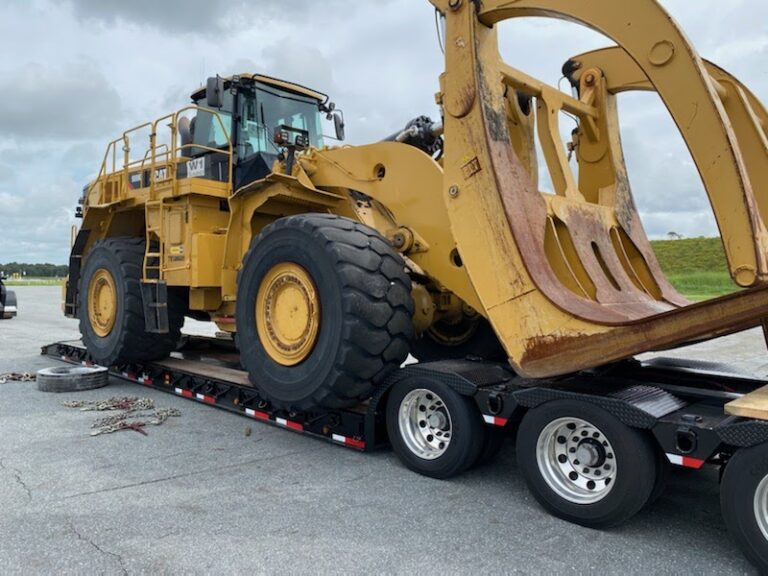5 Things to Know About Shipping Equipment Overseas
If you’re thinking of shipping heavy equipment internationally, several things need to be considered. Shipping procedures are more complex than those used for local or even national transport projects within the U.S., mainly because there is a lot of customs regulations and paperwork to complete, as well as logistics such as timescales and shipping costs to examine.

Meeting Customs Requirements is Critical for Overseas Equipment Transport
One of the most essential things to know about shipping equipment overseas involves customs regulations. All products shipped internationally, regardless of costs, type of shipment, or shipping medium, is required to clear the customs process. Typically, you’ll need to have two customs forms filled out. One for the country you reside in, and one for the destination country.
Customs Fees and Shipping Tariffs Vary Widely for International Equipment Transport
When heavy equipment is being shipped internationally, the customs department will issue a fee that takes into account the value of the product and the cargo’s destination. For example, a tower crane worth $400,000 being shipped to Germany may accrue $64,000 fees in taxes, but sending the same tower crane to the Netherlands may have an $84,000 tax value. Lower value equipment such as forklifts may have approx. $2,000 in fees attached. Check the customs fee rates for each country before you consider shipping.
Overseas Shipping Takes Longer
When shipping heavy equipment internationally, it’s crucial to determine the desired delivery date and plan your shipment carefully. In international shipping, there are far more chances of experiencing a delay in the shipping process that could affect your arrival date than there is for local transportation. Customs clearance may take longer than expected, and expedited overnight shipping may not be possible, so try to plan well in advance.
There Are Three Main Transport Options for International Equipment Shipping
When it comes to overseas shipping of equipment, you have three main shipping mediums to choose from. The best option for you will be determined by the cost, products, and time. On one hand, air freight is the fastest overseas shipping method, but it is the most expensive option. Sea freight, on the hand, is more affordable, but is a much slower transport option. Shipping by sea is also not considered appropriate for delicate cargo. However, items such as heavy construction equipment, are well-suited to sea transport options.
When it comes to international sea freight, three transportation types are available. Which method is appropriate depends on the size and dimensions of the equipment that you’re shipping. The three transportation methods are:
Many heavy equipment types can fit into standard-sized shipping containers. Standard ISO shipping containers are 8ft wide, 8.5ft tall, and either 20ft or 40ft in length. High-cube containers have an increased height of 9.5ft. This transport method is an excellent choice for several equipment types and is particularly useful if your equipment can be safely disassembled. Container shipping will typically involve crane loading the container onto the deck of the ship, so it can be slower to load and unload.
Ro-ro shipping can be considered if your heavy equipment delivery is a self-propelled machine. If it’s got wheels or treads that enable you to drive it onto a ship safely, you can utilize this option for a quicker loading and unloading process.
Flat rack shipping is an alternative option for heavy equipment that cannot be driven on or off the ship using the ro-ro shipping method. This type of transportation involves loading the machine onto a rack before it gets stacked onto the vessel.
Insurance is Recommended When Transporting Equipment Overseas
Unfortunately, the risk of damages is much higher for international shipments than it is for domestic shipping services. The heightened risks are due in part to how long the shipping process is, how many steps are involved in the shipping procedures, and how much your heavy machinery may be exposed to the elements if you choose ro-ro shipping. Therefore, it’s safer to ensure that your international heavy machinery export is covered for any damages, especially if they’re high value cargo.
It may seem like a hassle at first, but once you have confidently shipped a heavy machine overseas once, and you’ve familiarized yourself with all of the essential steps, subsequent shipments will be much easier to deal with.
Get Your International Transport Quote Today
Step 1: Fill Out Quote Form
Fill out the short & easy quote form.
Step 2: Speak With An Agent
We’ll pick up your heavy equipment or vehicle.
Step 3: Get Transported On Time
We deliver on time so you can get back to work.